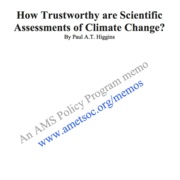By Paul A.T. Higgins ([email protected])
The views expressed in American Meteorological Society Policy Program memos are those of the author alone and do not necessarily reflect the views of the American Meteorological Society, its members, or sponsors.
Scientific evidence relating to the climate system and the impact that people might be having on it spans dozens of fields of study and includes work from tens of thousands of individual scientists. The evidence comes from decades of intensive research and is based on observations, field and laboratory experiments, and model simulations.
Over the past few decades, there have been hundreds of independent scientific assessments of this body of evidence. These assessments synthesize scientific research to determine what is known and with what level of confidence. Assessments have examined virtually every aspect of the climate issue, including how the climate system works, what is happening to it, why (the role of natural and human influences), what may happen in the future, what the consequences could be for natural and human systems, and what could be done to manage the risks. Many assessments are scientifically rigorous, produced using transparent processes, and include evaluation of uncertainty and confidence. Efforts to discredit scientific assessments with audiences that are unfamiliar with the underlying science or the processes used in preparing them are a disservice to science and the public.
This memo considers best practices in the assessment process, compares best practices with recent high-profile climate assessments, and identifies overarching scientific conclusions.
Effective Assessment Practices
Assessments of science are most effective when they are relevant to user needs; credible (scientifically rigorous and accurate); and legitimate (produced in a transparent and fair process). Credibility and legitimacy (this memo’s focus) are enhanced when assessments:
-
Are comprehensive. They consider all evidence whether supportive or contradictory of any particular conclusion.
-
Weigh evidence based on scientific merit. Evidence is strongest when sources of potential bias are controlled or minimized; experiments are well documented; results are independently reviewed, corroborated, withstand subsequent scrutiny of subject matter experts, and are consistent with physical laws. Conclusions that are based on multiple lines of evidence are particularly strong.
-
Are conducted by subject matter experts. Those who do assessments must be familiar with and able to judge evidence.
-
Include the full range of rigorous scientific opinion. The broadest possible range of scientifically defensible perspectives is included among those who participate in the assessment (i.e., those with scientifically credible disagreements).
-
Incorporate independent review. Broad and open reviews enable participation of all interested scientists, including those who have unconventional views; whose expertise is from other disciplines; or who are not fully established professionally. All comments from reviewers must be considered based on scientific merit and incorporated or addressed to the extent justified by that scientific merit.
-
Are overseen by institutions committed to scientific accuracy. Accuracy is a key objective of scientific institutions because it is central to their credibility and standing. Institutions that broadly represent science (e.g., The U.S. National Academy of Sciences) have particularly strong incentives to be accurate because mistakes they make in any field of science would diminish the institution’s credibility in all fields of science.
-
Are conducted transparently. Credibility increases through open processes and full disclosure of information relating to author selection, framing of questions, evidence included and excluded, evidence underlying major conclusions, review comments received, responses to comments, disagreements among authors and the process for resolution, the oversight and approval process, and potential conflicts of interest.
-
Continue to withstand scrutiny after public release. Scientists continue to examine assessments following publication. Those that stand up to wider scrutiny among subject matter experts and that remain accurate as new evidence emerges are particularly strong.
In contrast, efforts that selectively exclude legitimate scientific perspectives, consist of highly unrepresentative scientists, or do not incorporate independent expert review are suspect. Assessments conducted or funded by ideologically motivated groups; political institutions; issue advocates; or industry groups with financial interests require careful scrutiny to ensure they meet the criteria described above and appropriately manage potential conflicts of interest.
Overview of recent high-profile assessments
Over the past few decades, there have been hundreds of independent scientific assessments of climate change that comprehensively examined relevant evidence, including contradictory findings when they exist. Many of these assessments have been conducted by organizations whose primary objective is scientific accuracy and whose standing would be diminished if they characterized science inaccurately. This is broadly true for assessments conducted by the U.S. National Academy of Sciences, the Intergovernmental Panel on Climate Change (IPCC), the U.S. Government (i.e., the National Climate Assessment), the American Association for the Advancement of Science (AAAS); the American Meteorological Society (AMS), and many others. They involved broad groups of subject matter experts who are familiar with the evidence and included open independent review processes so those who disagree (or wish to add to them) could do so.
Preferences for erring on the side of caution (not alarm), challenges in including outcomes with unknown likelihoods, and desires for universal agreement, cause assessments such as these to underestimate the risk of climate change. Nevertheless, the assessments described above have routinely withstood intense scrutiny, particularly from those who are familiar with the relevant scientific evidence, following public release. They are highly credible. Decision-makers and the public can be confident these assessments are accurate syntheses of the best available scientific understanding. Efforts to discredit rigorous scientific assessments in public venues are not scientifically defensible and do a serious disservice to science and the public.
Bottom line
Findings reached independently by multiple assessments are particularly strong. Three broad conclusions follow from multiple highly credible assessments: 1) people are causing climate to change, particularly through emissions of greenhouse gases, 2) human-caused climate change poses very serious risks to humanity, and 3) there are many risk management options available that can meaningfully address climate change.
